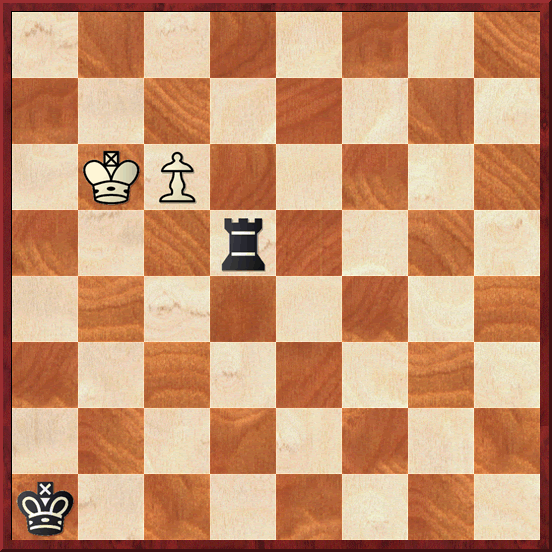 |
|
|
Fernando Saavedra
Born Seville, Spain, 1847 - Died Dublin, 1 May 1922
His name is associated with what, "is unquestionably the most famous of all endgame studies". (Roycroft)
The 'drama' associated with this position was played out in the chess columns of the Glasgow Weekly Citizen, edited by Georges Barbier, a Frenchman living in Glasgow who was Scottish champion in 1886.
In an April 1895 column Barbier wrote about the death of an English player, Potter. He included a position from one of Potter's games against Fenton (wrongly recalled, it turned out). Barbier gave the solution in his next column (May 4) and, at the same time, showed a similar position which he had constructed, the idea being that White plays 1. c7 and Black then draws because of an interesting stalemate position.
Glasgow Weekly Citizen, 1895.White plays 1. c7 and Black has to draw. The solution offered in the May 11 column was 1. ... Rd6+ 2. Kb5 Rd5+ 3. Kb4 Rd4+ 4. Kb3 Rd3+ 5. Kc2 Rd4! 6. c8=Q Rc4+ 7. Qxc4 1/2-1/2
However, in his May 18 column, Barbier announced that Saavedra, a member of Glasgow Chess Club, had pointed out a win for White. To present-day readers/players the solution may appear 'routine', as they have learned to look for such themes, but in 1895 it appears the idea of underpromotion caused a sensation. Saavedra showed that 6. c8=R wins for White after 6...Ra4 (to prevent mate) 7. Kb3, attacking the rook and threatening mate at c1.
History
For the full story on how the position came to be, see Tim Krabbé's detailed history at his Chess Curiosities web site.
See, also, another article at that web site (dated 2001), which seemed to throw doubt on the story.
A.J. Roycroft, who had written about the position in his excellent Test Tube Chess (1972), an introduction to the endgame study, then wrote an article for the British Chess Magazine (BCM), December 2001, and EG 143 for January 2002, which threw doubt on the doubter!
Roycroft had earlier written a detailed article for EG 122, October 1996, in which he gave credit to the Dutchman John Selman for his rigourous research methods. It also mentions that Saavedra "at one time owned a few chess books". [See Final note.]
Other References
BCM 1970, p. 287 An item in Quotes and Queries (No. 2143) gives references to articles about Saavedra, and states he was a member of a religious order, the Brothers of the Passion, since 1866.
BCM 1984, p. 403 An article titled 'The Saavedra Saga by the Scottish player Ian Mullen. He had come across an undated chess column believed to be from the Falkirk Herald of around 1910. The writer (likely A.J. Neilson) comments that he was "present at the 'birth' of this end-game, which took place in Glasgow Chess Club one afternoon." It is also stated that others there at the time were Sheriff Spens, W. Black, and Barbier.
Chess Notes The website of chess historian Edward Winter
CN 5796 comments on the history of the Saavedra position.
CN 5805 has a photograph of Saavedra's gravestone.
The Oxford Companion to Chess by David Hooper and Ken Whyld. Staes that the Saavedra position "inspired other composers, among them Liburkin and Lommer."
Additional Notes
Saavedra played for the West of Scotland in the 1892 and 1894 matches against East of Scotland.
[His name is wrongly shown in the 1892 BCM report as F. Soavedra.]As a member of the Passionists religious order, Saavedra served in several countries. He left Scotland for Australia but returned to Glasgow. In a Quotes & Queries article (No. 4403) in the British Chess Magazine 1985, p. 125, Ken Whyld notes that Saavedra played unsuccessfully on bottom board for Glasgow in 1915 (as shown in the BCM p. 131).
In the Valuation Roll for Glasgow 1915-16, page 128 there is an entry for The Trustees of the Community of the Marist Brothers at 48 Parson Street, Glasgow. Saavedra is included in this listing. The Monastery and House are listed at 52 Parson Street (St Mungo Roman Catholic Church).
Saavedra is buried in the churchyard of the Brothers of the Passion at Mount Argus, Dublin.
Final note
The Chess Scotland historian has in his possession a book donated to Glasgow CC by Saavedra - The Chess Players's Annual and Club Directory 1891 - inscribed, 'Presented to the Glasgow Chess Club, by the Revd. D.F. Saavedra. 21st May 1894.
Alan McGowan
Updated - 23/01/2019
|
|
